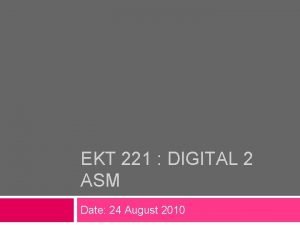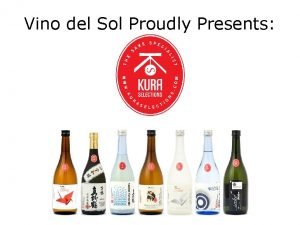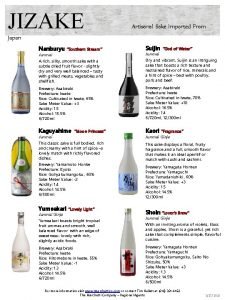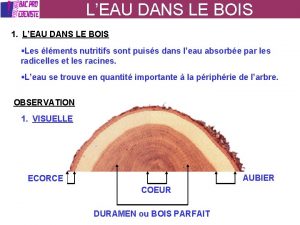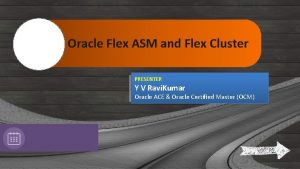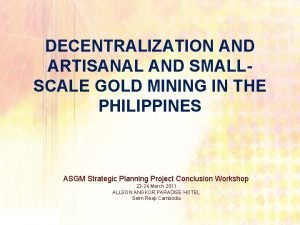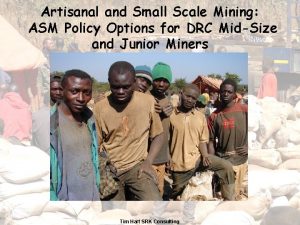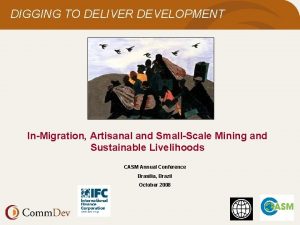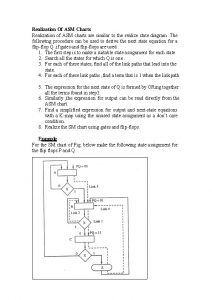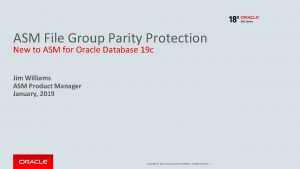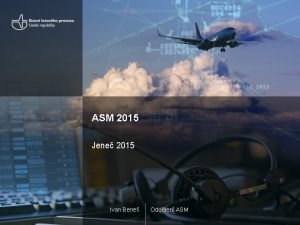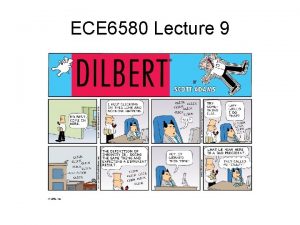Understanding Artisanal and SmallScale Mining ASM How your










- Slides: 10

Understanding Artisanal and Small-Scale Mining (ASM) How your company can drive positive impact in producing countries (upstream) 1

Content Understanding ASM • Mining landscape in producing countries • Artisanal and small-scale mining (ASM) • Why ASM is important • Risks related to ASM • Why engaging with ASM 2

• Large Scale Mining: • Highly professionalised • Long mining licences • Heavy machinery • Small Scale Mining: • Semi mechanised • Some machines such as excavators and bulldozers • Artisanal mining: • Small groups and/or individuals • Labour intensive • Rudimentary equipment (e. g. shovels, picks, basins) • Difficult access to finance Photo Credit: Magnus Arrevad Mining landscape 3

Artisanal and smallscale mining as a livelihood and business Photo Credit: Magnus Arrevad • Estimated 40. 5 million ASM • Involved in the extraction of about 30 mineral commodities • 70 -80% of ASM are informal (please see slide 5) • Gold is the commodity most extracted by ASM (20% of the global gold supply) • It offers a source of immediate cash when other employment opportunities are missing or are difficult to access • It can give higher sources of revenue compared to other business activities 4

Why artisanal and small-scale mining is important Artisanal and small-scale mining is an important factor in local social and economic development: • Artisanal and small-scale mining is present in 80 countries and it is a source of income and revenue in rural areas, esp. for people with few other options. • Economic forward and backward linkages – economic diversification. • 90% of the mining in the world is carried out by artisanal and small-scale mining (large employment source) – but only 10% of all the minerals come from ASM. o 80% of the global sapphires and 20% of diamonds come from ASM o ~20% of the global gold production in the world comes from ASM o 26% of global tantalum production and 25% of tin production and 6% of tungsten come from ASM o 3% of lead, 1% of zinc and 0. 5% of copper come from ASM o Demand for electronics and electric vehicle batteries is leading to an increase in artisanal and small-scale mining activities in cobalt mining 5

Some risks related to the ASM sector • • Informality (often don’t or can’t fulfil all the legal requirements) Health and safety and working conditions (pits collapsing, malaria, flooding, dust diseases, etc. ) Worst forms of child labour, forced or bonded labour, other human rights risks Financing of conflict or criminal activities Informal taxation and corruption by those who are supposed to regulate the ASM sector Local disputes or conflict over land use Environmental impacts – depending on mineral extracted. Deforestation, soil and water contamination, use of chemicals (mercury, cyanide, etc. ) v These are risks and they are NOT automatically prevalent in each ASM operation. They can occur, but are not intrinsic to all ASM. v These impacts/risks are NOT specific to ASM only. Tax evasion and corruption are also linked to LSM. ASM pay high “level of taxes” informally – these include bribes to officials, security and check points etc. 6

Why engage with ASM? If due diligence is properly carried out, engaging with ASM can have positive impacts, such as: • • Secure diverse and new sources of supply and respond to increasing consumer interest in materials and products that benefit producer communities. Foster sustainable economic development in mining communities (contributing to the SDGs). Foster sustainable economic development in mining communities, increase public revenues (contributing to the SDGs). Reduce the share of minerals that finances conflict, human rights abuses and illicit activities of armed groups, criminal networks and terrorist organisations. (Source: FAQ - Responsible Supply Chains in Artisanal and Small-Scale Gold 7 Mining)

Learn more about ASM • Global Trends in Artisanal and Small-Scale Mining (ASM): A review of key numbers and issues • FAQ - Responsible Supply Chains in Artisanal and Small-Scale Gold Mining • Working together: How large-scale mining can engage with artisanal and small-scale miners • Backgrounder: Artisanal and Small–Scale Mining (ASM) in Developing Countries 8

Some existing initiatives to engage with • • Fairmined (gold) Fairtrade (gold and silver) Just Gold (gold) Commercially viable, conflict-free supply chain of Artisanal and Small-scale Mining (ASM) gold (gold) Impact Facility Better Gold Initiative (gold) European Partnership for Responsible Minerals 9 Local NGOs’ initiatives

Thank you For further information visit the Due Diligence Ready! portal 10
